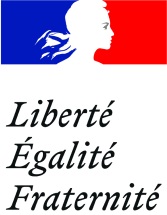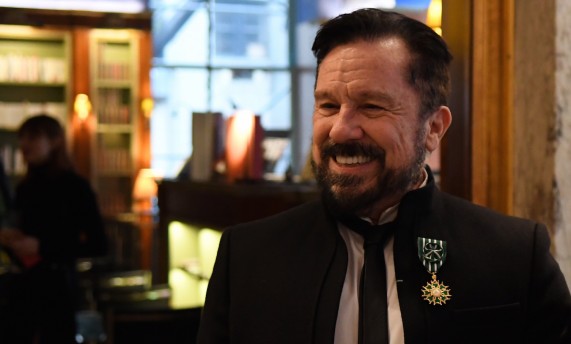On April 17, 2018, Peter Marino was honored with the insignia of Officer of the Order of Arts and Letters for his work in art and architecture in a ceremony held at the Cultural Services of the French Embassy in New York.
Good evening,
As Cultural Counselor, it is my pleasure to welcome you here to the Cultural Services of the French Embassy to bestow the insignia of Officer of the Order of Arts and Letters upon internationally renowned architect, Peter Marino.
In 1957, the Order of Arts and Letters was established by the French government to recognize renowned artists and writers and those who have contributed significantly to furthering the arts in France and throughout the world.
Peter Marino,
We recognize you today for the vast influence you have made globally to art and architecture as one of the most prolific and innovative architects and interior designers of our time, and for the immense contributions you have made as a champion of French and international art.
You began your career with a degree in architecture from Cornell University in New York. Since then, you have spent your thriving career designing culturally significant buildings around the world, and you have worked extensively in connection with France. You are now the principal of the 160-person, New York-based Peter Marino Architect PLLC, which you founded in 1978. Your impressive list of architectural creations includes flagships for Dior, Chanel, Louis Vuitton, Celine, Guerlain, the Cheval Blanc hotel in Paris’ historic La Samaritaine, as well as residences in Paris, Cap Ferrat, and St. Tropez, and restorations of Château Rauzan-Segla and Château de Blérancourt. We celebrate these contributions tonight.
Peter, you come to us here today having made one of your most significant contributions to French architecture and culture just a few months ago, in October 2017, when you designed the new Maison Louis Vuitton Vendôme in Paris. It was at the Place Vendôme where over 160 years ago, Monsieur Vuitton opened his first store, and your remarkable update to the building’s exterior, and rebuilding of the interior, is the perfect way to mark this “homecoming.” You reinvigorated the 1714 building, first designed by Versailles architect Jules-Hardouin Mansart, with care and integrity, and your team used 18th-century techniques referencing French craftsmanship. You also worked with French artisans to fill the store with stunning pieces and invited many contemporary artists for site-specific installations. With your extensive knowledge of materials, luxury craft, art history, and of contemporary design, you have fearlessly and skillfully infused contemporary art into historic spaces and have created some of the most visually appealing and striking spaces while retaining traditional aesthetic integrity.
Some of your other recent projects include redesigning Louis Vuitton’s concept in Soho in 2016 and designing Dior’s mega-store in Seoul, which incorporates numerous commissioned art and design pieces like the benches by French artists Claude and François-Xavier Lalanne.
Out of your numerous projects, one of my personal favorites is from 2004: you designed Chanel’s largest boutique in the world, the Chanel Tower Ginza in Tokyo, a 10-floor glass palace with an exterior made to mimic the Chanel signature tweed pattern that involves innovative LED light technology allowing office workers to see out during the day but lights up for display at night. It was Coco Chanel who said “fashion is architecture,” underlining the importance to her of structure and line. Having designed no fewer than 12 boutiques for Chanel, you yourself have been quoted to say, referring to your design of Chanel Boston in particular, that it is like a work of couture. Indeed, being a proponent of the concept of fluidity among architecture, art, and couture situates you squarely in the evolving thinking of our time.
As your career in architecture has brought you into close appreciation of art, you also collect it avidly, especially French porcelain, contemporary paintings, modern art, and French and Italian bronzes from the mid-16th to the mid-18th century. One can expect to find you at an art gallery each Saturday. Your personal collection of bronzes has been displayed at London’s Wallace Collection, L.A.’s Huntington Library, and the Minneapolis Institute of Art. Your connection with art is so integral to you that your friend Jerôme Sans, an international curator and the cofounder of Palais de Tokyo in Paris, organized the exhibition “One Way: Peter Marino” at the Bass Museum in Miami, which detailed your relationship with art as a collector and collaborator and was enormously popular at the Art Basel Miami 2014 exhibition.
As it happens, Andy Warhol was someone who furthered your interest in collecting art. He hired you in 1978 to redesign his townhouse on the Upper East Side, and then to design the third iteration of his studio, commonly known as Warhol’s Factory. You quickly became friends, and you became ever more engaged with art.
There have been few architects who have emphasized such collaboration between architecture and the visual arts as you have. And in this way, you have not only been a great supporter of contemporary artists, but have also offered new ways of viewing architecture and design. You have commissioned over 300 site-specific works and have collaborated with world-famous contemporary artists such as Jean-Michel Othoniel, James Turrel, Vanessa Beecroft, Johann Creteen, Tony Cragg, and Olafur Eliasson to invigorate your spaces. This unique vision of yours is so noteworthy that it has resulted in a book called Peter Marino: Art Architecture, published by Phiadon in 2016, which celebrates your collaboration with artists. Andy Warhol once prophesized that “all department stores will become museums,” and you have worked to make your friend’s prophecy come true.
Designing retail stores, the work for which you are most widely known today, took root in 1985 with your project for Barneys New York. Barneys was clearly blown away, because they hired you to design 17 more of their department stores. This initial connection with fashion retailers allowed you to connect with many more. It would be hard to name a luxury brand, in fact, that hasn’t at one point hired you to design a showplace: Dior, Chanel, Guerlain, Bulgari, Fendi, and Louis Vuitton are some of the many that rely on your exemplary vision to capture their concepts.
Your deep appreciation for modern and contemporary art, along with your tremendous knowledge of the old traditions of craftsmanship and antiques, and your impeccable sensibility have led you to produce a truly groundbreaking body of work. You have captured what it means to be a contemporary architect and interior designer who views design as part of a greater narrative and sees the arts as in constant dialogue with each other. For your visionary design and commitment to French art and culture, it is my pleasure to present you with the insignia of Officer of the Order of Arts and Letters.
Peter Marino, au nom du gouvernement français, je vous fais Officier dans l’Ordre des Arts et des Lettres.



